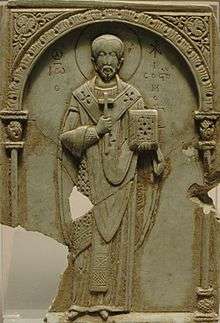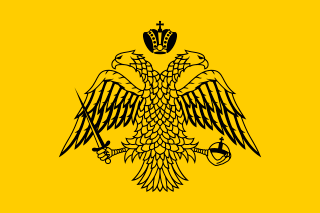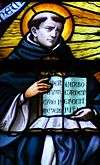John Chrysostom
| Saint John Chrysostom | |
|---|---|
 | |
| East: Great Hierarch and Ecumenical Teacher West: Bishop and Doctor of the Church | |
| Born |
c. 349[1] Antioch |
| Died |
14 September 407 (aged c. 58)[2] Comana in Pontus[3] |
| Venerated in |
Eastern Orthodoxy Roman Catholicism Oriental Orthodoxy Church of the East Anglican Communion |
| Canonized | Pre-congregational |
| Feast |
Byzantine Christianity 13 September (Repose—transferred from 14 September); 27 January (extraordinary form) |
| Attributes | Vested as a Bishop, holding a Gospel Book or scroll, right hand raised in blessing. He is depicted as emaciated from fasting, with a high forehead, balding with dark hair and a small beard. Symbols: beehive, a white dove, a pan,[4] chalice on a bible, pen and inkhorn |
| Patronage | Constantinople, education, epilepsy, lecturers, orators, preachers [4] |
John Chrysostom (/ˈkrɪsəstəm,
He is honored as a saint in the Oriental Orthodox, Eastern Orthodox, Catholic, Anglican, and Lutheran churches, as well as in some others. The Eastern Orthodox, together with the Byzantine Catholics, hold him in special regard as one of the Three Holy Hierarchs (alongside Basil the Great and Gregory of Nazianzus). The feast days of John Chrysostom in the Eastern Orthodox Church are 13 November and 27 January. In the Roman Catholic Church he is recognized as a Doctor of the Church and commemorated on 13 September in the current General Roman Calendar[9] and on 27 January in the older calendar. Other churches of the Western tradition, including some Anglican provinces and some Lutheran churches, also commemorate him on 13 September. However, certain Lutheran churches and Anglican provinces commemorate him on the traditional feast day of 27 January. The Coptic Church also recognizes him as a saint (with feast days on 16 Thout and 17 Hathor).[10]
Biography
Early life and education
John was born in Antioch in 349 to Greek parents from Syria. Different scholars describe his mother Anthusa as a pagan[11] or as a Christian, and his father was a high-ranking military officer.[12] John's father died soon after his birth and he was raised by his mother. He was baptised in 368 or 373 and tonsured as a reader (one of the minor orders of the Church).[13]
As a result of his mother's influential connections in the city, John began his education under the pagan teacher Libanius.[14] From Libanius, John acquired the skills for a career in rhetoric, as well as a love of the Greek language and literature.[15]
As he grew older, however, John became more deeply committed to Christianity and went on to study theology under Diodore of Tarsus, founder of the re-constituted School of Antioch. According to the Christian historian Sozomen, Libanius was supposed to have said on his deathbed that John would have been his successor "if the Christians had not taken him from us".[16]
John lived in extreme asceticism and became a hermit in about 375; he spent the next two years continually standing, scarcely sleeping, and committing the Bible to memory. As a consequence of these practices, his stomach and kidneys were permanently damaged and poor health forced him to return to Antioch.[17]
Diaconate and service in Antioch
John was ordained as a deacon in 381 by Saint Meletius of Antioch who was not then in communion with Alexandria and Rome. After the death of Meletius, John separated himself from the followers of Meletius, without joining Paulinus, the rival of Meletius for the bishopric of Antioch. But after the death of Paulinus he was ordained a presbyter (priest) in 386 by Evagrius, the successor of Paulinus.[18] He was destined later to bring about reconciliation between Flavian I of Antioch, Alexandria, and Rome, thus bringing those three sees into communion for the first time in nearly seventy years.[19]
In Antioch, over the course of twelve years (386–397), John gained popularity because of the eloquence of his public speaking at the Golden Church, Antioch's cathedral, especially his insightful expositions of Bible passages and moral teaching. The most valuable of his works from this period are his Homilies on various books of the Bible. He emphasised charitable giving and was concerned with the spiritual and temporal needs of the poor. He spoke against abuse of wealth and personal property:
Do you wish to honour the body of Christ? Do not ignore him when he is naked. Do not pay him homage in the temple clad in silk, only then to neglect him outside where he is cold and ill-clad. He who said: "This is my body" is the same who said: "You saw me hungry and you gave me no food", and "Whatever you did to the least of my brothers you did also to me"... What good is it if the Eucharistic table is overloaded with golden chalices when your brother is dying of hunger? Start by satisfying his hunger and then with what is left you may adorn the altar as well.[20]
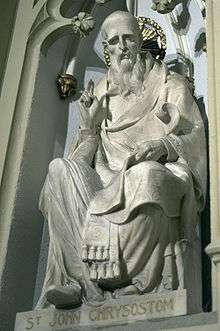
His straightforward understanding of the Scriptures – in contrast to the Alexandrian tendency towards allegorical interpretation – meant that the themes of his talks were practical, explaining the Bible's application to everyday life. Such straightforward preaching helped Chrysostom to garner popular support. He founded a series of hospitals in Constantinople to care for the poor.[21]
One incident that happened during his service in Antioch illustrates the influence of his homilies. When Chrysostom arrived in Antioch, Flavian, the bishop of the city, had to intervene with Emperor Theodosius I on behalf of citizens who had gone on a rampage mutilating statues of the Emperor and his family. During the weeks of Lent in 387, John preached more than twenty homilies in which he entreated the people to see the error of their ways. These made a lasting impression on the general population of the city: many pagans converted to Christianity as a result of the homilies. As a result, Theodosius' vengeance was not as severe as it might have been.[6]
Archbishop of Constantinople
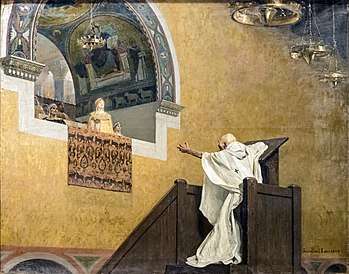
In the autumn of 397, John was appointed Archbishop of Constantinople, after having been nominated without his knowledge by the eunuch Eutropius. He had to leave Antioch in secret due to fears that the departure of such a popular figure would cause civil unrest.[22]
During his time as Archbishop he adamantly refused to host lavish social gatherings, which made him popular with the common people, but unpopular with wealthy citizens and the clergy. His reforms of the clergy were also unpopular. He told visiting regional preachers to return to the churches they were meant to be serving—without any payout.[23]
His time in Constantinople was more tumultuous than his time in Antioch. Theophilus, the Patriarch of Alexandria, wanted to bring Constantinople under his sway and opposed John's appointment to Constantinople. Theophilus had disciplined four Egyptian monks (known as "the Tall Brothers") over their support of Origen's teachings. They fled to John and were welcomed by him. Theophilus therefore accused John of being too partial to the teaching of Origen. He made another enemy in Aelia Eudoxia, wife of Emperor Arcadius, who assumed that John's denunciations of extravagance in feminine dress were aimed at her.[6] Eudoxia, Theophilus and other of his enemies held a synod in 403 (the Synod of the Oak) to charge John, in which his connection to Origen was used against him. It resulted in his deposition and banishment. He was called back by Arcadius almost immediately, as the people became "tumultuous" over his departure, even threatening to burn the royal palace.[24] There was an earthquake the night of his arrest, which Eudoxia took for a sign of God's anger, prompting her to ask Arcadius for John's reinstatement.[25]
Peace was short-lived. A silver statue of Eudoxia was erected in the Augustaion, near his cathedral. John denounced the dedication ceremonies as pagan and spoke against the Empress in harsh terms: "Again Herodias raves; again she is troubled; she dances again; and again desires to receive John's head in a charger",[26] an allusion to the events surrounding the death of John the Baptist. Once again he was banished, this time to the Caucasus in Abkhazia.[27]
Around 405, John began to lend moral and financial support to Christian monks who were enforcing the emperors' anti-Pagan laws, by destroying temples and shrines in Phoenicia and nearby regions.[28]
Exile and death
The causes of John's exile are not clear, though Jennifer Barry suggests that they have to do with his connections to Arianism. Other historians, including Wendy Mayer and Geoffrey Dunn, have argued that "the surplus of evidence reveals a struggle between Johannite and anti-Johannite camps in Constantinople soon after John's departure and for a few years after his death".[29] Faced with exile, John Chrysostom wrote an appeal for help to three churchmen: Pope Innocent I, Venerius the Bishop of Milan, and the third to Chromatius, the Bishop of Aquileia.[30][31][32] In 1872, church historian William Stephens wrote:
The Patriarch of the Eastern Rome appeals to the great bishops of the West, as the champions of an ecclesiastical discipline which he confesses himself unable to enforce, or to see any prospect of establishing. No jealousy is entertained of the Patriarch of the Old Rome by the Patriarch of the New Rome. The interference of Innocent is courted, a certain primacy is accorded him, but at the same time he is not addressed as a supreme arbitrator; assistance and sympathy are solicited from him as from an elder brother, and two other prelates of Italy are joint recipients with him of the appeal.[33]
Pope Innocent I protested John's banishment from Constantinople to the town of Cucusus in Cappadocia, but to no avail. Innocent sent a delegation to intercede on behalf of John in 405. It was led by Gaudentius of Brescia; Gaudentius and his companions, two bishops, encountered many difficulties and never reached their goal of entering Constantinople.[34]
John wrote letters which still held great influence in Constantinople. As a result of this, he was further exiled from Cucusus (where he stayed from 404 to 407) to Pitiunt (Pityus) (in modern Georgia) where his tomb is a shrine for pilgrims. He never reached this destination, as he died at Comana Pontica on 14 September 407 during the journey. His last words are said to have been "δόξα τῷ θεῷ πάντων ἕνεκεν" (Glory be to God for all things).[25]
Veneration and canonization
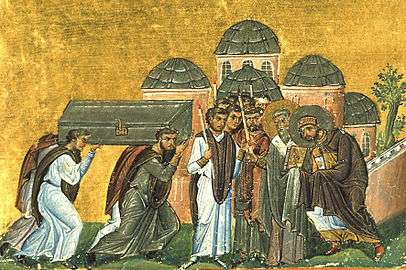
John came to be venerated as a saint soon after his death. Almost immediately after, an anonymous supporter of John (known as pseudo-Martyrius) wrote a funeral oration to reclaim John as a symbol of Christian orthodoxy.[29] But three decades later, some of his adherents in Constantinople remained in schism.[35] Saint Proclus, Patriarch of Constantinople (434–446), hoping to bring about the reconciliation of the Johannites, preached a homily praising his predecessor in the Church of Hagia Sophia. He said, "O John, your life was filled with sorrow, but your death was glorious. Your grave is blessed and reward is great, by the grace and mercy of our Lord Jesus Christ O graced one, having conquered the bounds of time and place! Love has conquered space, unforgetting memory has annihilated the limits, and place does not hinder the miracles of the saint."[36]
These homilies helped to mobilize public opinion, and the patriarch received permission from the emperor to return Chrysostom's relics to Constantinople, where they were enshrined in the Church of the Holy Apostles on 28 January 438. The Eastern Orthodox Church commemorates him as a "Great Ecumenical Teacher", with Basil the Great and Gregory the Theologian. These three saints, in addition to having their own individual commemorations throughout the year, are commemorated together on 30 January, a feast known as the Synaxis of the Three Hierarchs.[37]
There are several feast days dedicated to him:
- 27 January, Translation of the relics of Saint John Chrysostom from Comana to Constantinople
- 30 January, Synaxis of the Three Great Hierarchs
- 14 September, Repose of Saint John Chrysostom
- 13 November, Saint John Chrysostom the Archbishop of Constantinople
Writings
Homilies
Paschal Homily
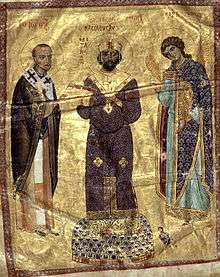
The best known of his many homilies, the Paschal Homily (Hieratikon), is rather brief. In the Eastern Orthodox Church it is traditionally read in full each year at the Paschal Divine Liturgy (eucharistic) service following the midnight Orthros (or Matins).
General
Chrysostom's extant homiletical works are vast, including many hundreds of exegetical homilies on both the New Testament (especially the works of Saint Paul) and the Old Testament (particularly on Genesis). Among his extant exegetical works are sixty-seven homilies on Genesis, fifty-nine on the Psalms, ninety on the Gospel of Matthew, eighty-eight on the Gospel of John, and fifty-five on the Acts of the Apostles.[38]
The homilies were written down by stenographers and subsequently circulated, revealing a style that tended to be direct and greatly personal, but formed by the rhetorical conventions of his time and place.[39] In general, his homiletical theology displays much characteristic of the Antiochian school (i.e., somewhat more literal in interpreting Biblical events), but he also uses a good deal of the allegorical interpretation more associated with the Alexandrian school.[38]
John's social and religious world was formed by the continuing and pervasive presence of paganism in the life of the city. One of his regular topics was the paganism in the culture of Constantinople, and in his homilies he thunders against popular pagan amusements: the theatre, horseraces, and the revelry surrounding holidays.[40] In particular, he criticizes Christians for taking part in such activities:
If you ask [Christians] who is Amos or Obadiah, how many apostles there were or prophets, they stand mute; but if you ask them about the horses or drivers, they answer with more solemnity than sophists or rhetors.[41]
One of the recurring features of John's homilies is his emphasis on care for the needy.[42] Echoing themes found in the Gospel of Matthew, he calls upon the rich to lay aside materialism in favor of helping the poor, often employing all of his rhetorical skills to shame wealthy people to abandon conspicuous consumption:
Do you pay such honor to your excrements as to receive them into a silver chamber-pot when another man made in the image of God is perishing in the cold?[43]
Homilies against Jews and Judaizing Christians
During his first two years as a presbyter in Antioch (386–387), John denounced Jews and Judaizing Christians in a series of eight homilies delivered to Christians in his congregation who were taking part in Jewish festivals and other Jewish observances.[44] It is disputed whether the main target were specifically Judaizers or Jews in general. His homilies were expressed in the conventional manner, utilizing the uncompromising rhetorical form known as the psogos (Greek: blame, censure).
One of the purposes of these homilies was to prevent Christians from participating in Jewish customs, and thus prevent the perceived erosion of Chrysostom's flock. In his homilies, John criticized those "Judaizing Christians", who were participating in Jewish festivals and taking part in other Jewish observances, such as the shabbat, submitted to circumcision and made pilgrimage to Jewish holy places.[45]
John claimed that synagogues were full of Christians, especially Christian women, on the shabbats and Jewish festivals, because they loved the solemnity of the Jewish liturgy and enjoyed listening to the shofar on Rosh Hashanah, and applauded famous preachers in accordance with the contemporary custom.[46] A more recent theory is that he instead tried to persuade Jewish Christians, who for centuries had kept connections with Jews and Judaism, to choose between Judaism and Christianity.[47]
In Greek the homilies are called Kata Ioudaiōn (Κατὰ Ιουδαίων), which is translated as Adversus Judaeos in Latin and Against the Jews in English.[48] The original Benedictine editor of the homilies, Bernard de Montfaucon, gives the following footnote to the title: "A discourse against the Jews; but it was delivered against those who were Judaizing and keeping the fasts with them [the Jews]."[48]
According to Patristics scholars, opposition to any particular view during the late 4th century was conventionally expressed in a manner, utilizing the rhetorical form known as the psogos, whose literary conventions were to vilify opponents in an uncompromising manner; thus, it has been argued that to call Chrysostom an "anti-Semite" is to employ anachronistic terminology in a way incongruous with historical context and record.[49] This does not preclude assertions that Chrysostom's theology was a form of Anti-Jewish supersessionism.[50]
Homily against homosexuality
Chrysostom loathed homosexuality.[51] His most notable discourse in this regard is his fourth homily on Romans 1:26–27, where he argues that those who have sex with the same gender must do so because they are insane:
All of these affections then were vile, but chiefly the mad lust after males; for the soul is more the sufferer in sins, and more dishonored than the body in diseases. ... [The men] have done an insult to nature itself. And a yet more disgraceful thing than these is it, when even the women seek after these intercourses, who ought to have more shame than men.[52]
He describes homosexuality as the worst of sins, greater than murder. He asserts that punishment will be found in hell for such transgressors, and that women can be guilty of the sin as much as men (although the former disrupt the patriarchal hierarchy through such an act). Chrysostom argues that the male passive partner has effectively renounced his manhood and become a woman – such an individual deserves to be "driven out and stoned". Chrysostom was particularly influential in shaping early Christian thought that same-sex desire was an evil that ultimately resulted in social injustice – altering the traditional interpretation of Sodom as a place of inhospitality, to one where the sexual transgressions of the Sodomites became paramount.[53] Allen describes the sermon as the "climax and consummation of homophobia in the late classical world".[54]
Treatises
Apart from his homilies, a number of John's other treatises have had a lasting influence. One such work is John's early treatise Against Those Who Oppose the Monastic Life, written while he was a deacon (sometime before 386), which was directed to parents, pagan as well as Christian, whose sons were contemplating a monastic vocation.[55] Chrysostom wrote that, already in his day, it was customary for Antiochenes to send their sons to be educated by monks.[56]
Another important treatise written by John is titled On the Priesthood (written 390/391, it contains in Book 1 an account of his early years and a defence of his flight from ordination by Bishop Meletios of Antioch, and then proceeds in later books to expound on his exalted understanding of the priesthood). Two other notable books by John are Instructions to Catechumens and On the Incomprehensibility of the Divine Nature.[57] In addition, he wrote a series of letters to the deaconess Olympias, of which seventeen are extant.[58]
Liturgy
Beyond his preaching, the other lasting legacy of John is his influence on Christian liturgy. Two of his writings are particularly notable. He harmonized the liturgical life of the Church by revising the prayers and rubrics of the Divine Liturgy, or celebration of the Holy Eucharist. To this day, Eastern Orthodox and Eastern Catholic Churches of the Byzantine Rite typically celebrate the Divine Liturgy of Saint John Chrysostom as the normal Eucharistic liturgy, although his exact connection with it remains a matter of debate among experts.[59]
Legacy and influence
During a time when city clergy were subject to criticism for their high lifestyle, John was determined to reform his clergy in Constantinople. These efforts were met with resistance and limited success. He was an excellent preacher[59] whose homilies and writings are still studied and quoted. As a theologian, he has been and continues to be very important in Eastern Christianity, and is generally considered among the Three Holy Hierarchs of the Greek Church, but has been less important to Western Christianity. His writings have survived to the present day more so than any of the other Greek Fathers.[2]
Influence on the Catechism of the Catholic Church and clergy
John's influence on church teachings is interwoven throughout the current Catechism of the Catholic Church (revised 1992). The Catechism cites him in eighteen sections, particularly his reflections on the purpose of prayer and the meaning of the Lord's Prayer:
Consider how [Jesus Christ] teaches us to be humble, by making us see that our virtue does not depend on our work alone but on grace from on high. He commands each of the faithful who prays to do so universally, for the whole world. For he did not say "thy will be done in me or in us", but "on earth", the whole earth, so that error may be banished from it, truth take root in it, all vice be destroyed on it, virtue flourish on it, and earth no longer differ from heaven.[60]
Christian clerics, such as R. S. Storr, refer to him as "one of the most eloquent preachers who ever since apostolic times have brought to men the divine tidings of truth and love", and the 19th-century John Henry Newman described John as a "bright, cheerful, gentle soul; a sensitive heart."[61]
Music and literature
John's liturgical legacy has inspired several musical compositions. Particularly noteworthy are Sergei Rachmaninoff's Liturgy of St. John Chrysostom, Op. 31, composed in 1910,[62] one of his two major unaccompanied choral works; Pyotr Tchaikovsky's Liturgy of St. John Chrysostom, Op. 41; and Ukrainian composer Kyrylo Stetsenko's Liturgy of St. John Chrysostom. Arvo Pärt's Litany sets Chrysostom's twenty-four prayers, one for each hour of the day,[63] for soli, mixed choir and orchestra. And the compositions of Alexander Grechaninovs "Liturgy of Johannes Chrysostomos No. 1, Op. 13 (1897)", "Liturgy of Johannes Chrysostomos No. 2, Op.29 (1902)", "Liturgia Domestica (Liturgy Johannes Chrysostomos No. 3), Op. 79 (1917)" and "Liturgy of Johannes Chrysostomos No. 4, Op. 177 (1943)" are noteworthy.
James Joyce's novel Ulysses includes a character named Mulligan who brings 'Chrysostomos' into another character (Stephen Dedalus)'s mind because Mulligan's gold-stopped teeth and his gift of the gab earn him the title which St. John Chrysostom's preaching earned him, 'golden-mouthed':[64] "[Mulligan] peered sideways up and gave a long low whistle of call, then paused awhile in rapt attention, his even white teeth glistening here and there with gold points. Chrysostomos."[65]
The legend of the penance of Saint John Chrysostom
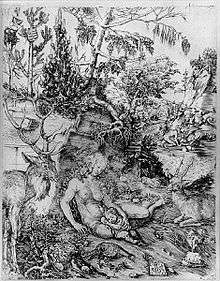
A late medieval legend (not included in the Golden Legend) relates that, when John Chrysostom was a hermit in the desert, he was approached by a royal princess in distress.[66] The Saint, thinking she was a demon, at first refused to help her, but the princess convinced him that she was a Christian and would be devoured by wild beasts if she were not allowed to enter his cave. He therefore admitted her, carefully dividing the cave in two parts, one for each of them. In spite of these precautions, the sin of fornication was committed, and in an attempt to hide it the distraught saint took the princess and threw her over a precipice. He then went to Rome to beg absolution, which was refused. Realising the appalling nature of his crimes, Chrysostom made a vow that he would never rise from the ground until his sins were expiated, and for years he lived like a beast, crawling on all fours and feeding on wild grasses and roots. Subsequently, the princess reappeared, alive, and suckling the saint's baby, who miraculously pronounced his sins forgiven. This last scene was very popular from the late 15th century onwards as a subject for engravers and artists. The theme was depicted by Albrecht Dürer around 1496,[67] Hans Sebald Beham and Lucas Cranach the Elder, among others. Martin Luther mocked this same legend in his Die Lügend von S. Johanne Chrysostomo (1537).[68][69] The legend was recorded in Croatia in the 16th century.[70]
Relics
John Chrysostom died in the city of Comana in the year 407 on his way to his place of exile. There his relics remained until 438 when, thirty years after his death, they were transferred to Constantinople during the reign of the Empress Eudoxia's son, the Emperor Theodosius II (408–450), under the guidance of John's disciple, St. Proclus, who by that time had become Archbishop of Constantinople (434–447).
Most of John's relics were looted from Constantinople by Crusaders in 1204 and taken to Rome, but some of his bones were returned to the Orthodox Church on 27 November 2004 by Pope John Paul II.[71] They are now enshrined in the Church of St. George, Istanbul.[72]
The skull, however, having been kept at the monastery at Vatopedi on Mount Athos in northern Greece, was not among the relics that were taken by the crusaders in the 13th century. In 1655, at the request of Tsar Alexei Mikhailovich, the skull was taken to Russia, for which the monastery was compensated in the sum of 2000 rubles. In 1693, having received a request from the Vatopedi Monastery for the return of Saint John's skull, Tsar Peter the Great ordered that the skull remain in Russia but that the monastery was to be paid 500 rubles every four years. The Russian state archives document these payments up until 1735. The skull was kept at the Moscow Kremlin, in the Cathedral of the Dormition of the Mother of God, until 1920, when it was confiscated by the Soviets and placed in the Museum of Silver Antiquities. In 1988, in connection with the 1000th Anniversary of the Baptism of Russia, the head, along with other important relics, was returned to the Russian Orthodox Church and kept at the Epiphany Cathedral, until being moved to the Cathedral of Christ the Saviour after its restoration.
Today, the monastery at Vatopedi posits a rival claim to possessing the skull of John Chrysostom, and there a skull is venerated by pilgrims to the monastery as that of Saint John. Two sites in Italy also claim to have the saint's skull: the Basilica di Santa Maria del Fiore in Florence and the Dal Pozzo chapel in Pisa. The right hand of Saint John[73] is preserved on Mount Athos, and numerous smaller relics are scattered throughout the world.[74]
Notes
- ↑ The exact date of John's birth is in question, and dates between 344 and 349 are given. In the most recent general biography of Chrysostom, eminent patristics scholar JND Kelly, after a review of the evidence and literature, favours 349 as the date that best fits all available evidence, in agreement with Robert Carter. See Kelly, Golden Mouth: The Story of John Chrysostom: Ascetic, Preacher, Bishop, (Grand Rapids: Baker Academic 1998: originally published Ithaca: Cornell University Press, 1995), p. 4 fn. 12; esp. Appendix B passim. For a discussion of alternatives presented in the literature, see Robert Carter, "The Chronology of St. John Chrysostom's Early Life", in Traditio 18:357–64 (1962); Jean Dumortier, "La valeur historique du dialogue de Palladius et la chronologie de saint Jean Chrysostome", in Mélanges de science religieuse, 8:51–56 (1951). Carter dates his birth to the year 349. See also Robert Louis Wilken, John Chrysostom and the Jews: Rhetoric and Reality in the Late Fourth Century, (Berkeley: University of California Press: 1983), p. 5.
- 1 2 3 "St John Chrysostom" profile, Catholic Encyclopedia (see here); retrieved 20 March 2007.
- ↑ "CATHOLIC ENCYCLOPEDIA: St. John Chrysostom". www.newadvent.org.
- 1 2 "Catholic-forum.com". Archived from the original on 17 January 2008.
- ↑ The exact date of John's birth is in question, and dates between 344 and 349 are often given, and limits set at 340 and 350 (Kelly 296). In the most recent general biography of Chrysostom, eminent patristics scholar JND Kelly, after a review of the evidence and literature, favours 349 as the date that best fits all available evidence, in agreement with Robert Carter. See Kelly, Golden Mouth: The Story of John Chrysostom: Ascetic, Preacher, Bishop, Grand Rapids, MI: Baker Academic, 1998: originally published Ithaca: Cornell University Press, 1995), p. 4 fn. 12; esp. 296–298 passim. For a concurring analysis which is followed in most recent reconstructions of the early life of Chrysostomos, see Robert Carter, "The Chronology of St. John Chrysostom's Early Life", in Traditio 18:357–64 (1962). For a discussion of alternatives, often in older literature, see especially G. Ettlinger, Traditio 16 (1960), pp. 373–80, Jean Dumortier, "La valeur historique du dialogue de Palladius et la chronologie de saint Jean Chrysostome", Mélanges de science religieuse, 8:51–56 (1951)
- 1 2 3 Robert Wilken, "John Chrysostom" profile, Encyclopedia of Early Christianity (ed. Everett Ferguson), New York: Garland Publishing, 1997
- ↑ Pope Vigilius, Constitution of Pope Vigilius, pg. 553
- ↑ Writings of Chrysostom in the Christian Classics Ethereal Library edition of the Nicene and Post-Nicene Fathers:. Six full volumes by Chysostom, compared to eight full volumes for Augustine.
- ↑ "Calendarium Romanum" (in Latin). Typis Polyglottis Vaticanis. 1969. pp. 102–103. Retrieved 12 September 2018.
- ↑ Coptic synaxarium Archived 27 March 2009 at the Wayback Machine.
- ↑ "John Chrysostom", Encyclopaedia Judaica
- ↑ The Encyclopaedia Judaica describes Chrysostom's mother as a pagan. In Pauline Allen and Wendy Mayer, John Chrysostom (pg. 5), she is described as a Christian.
- ↑ Wilken (p. 7) prefers 368 for the date of Chrysostom's baptism, the Encyclopaedia Judaica prefers the later date of 373.
- ↑ Cameron, Averil (1998) "Education and literary culture" in Cameron, A. and Garnsey, P. (eds.) The Cambridge ancient history: Vol. XIII The late empire, A.D. 337–425. Cambridge: Cambridge University Press, pg. 668.
- ↑ Wilken, pg. 5.
- ↑ Sozomen (1995) [1890]. "Ecclesiastical History of Sozomen, Book VIII, Chapter II: Education, Training, Conduct, and Wisdom of the Great John Chrysostom". In Schaff, Philip and Wace, Henry (trs., eds.). Nicene and Post-Nicene Fathers, Volume II: Socrates and Sozomenus Ecclesiastical Histories. Zenos, A. C. (rev., notes) (reprint ed.). Peabody, MA: Hendrickson Publishers. p. 399. ISBN 1-56563-118-8. Retrieved 29 March 2007.
- ↑ Allen, Pauline & Wendy Mayer, John Chrysostom, Routledge: 2000, pg. 6
- ↑ Scholasticus, Socrates. Ecclesiastical History, VI, 3
- ↑ Philip Hughes, History of the Church, Sheed and Ward, 1934, vol I, pp. 231–232.
- ↑ Chrysostom, John. In Evangelium S. Matthaei, homily 50:3–4, pp 58, 508–509
- ↑ Baluffi, Catejan. The Charity of the Church (trans. Denis Gargan), Dublin: M H Gill and Son, 1885, p. 39
Schmidt, Alvin J. Under the Influence: How Christianity Transformed Civilization, Grand Rapids, MI, Zondervan, 2001, p. 152 - ↑ Allen and Mayer, 2000, pg. 6
- ↑ Farmer, David H. The Oxford Dictionary of the Saints (2nd ed.), New York: Oxford University Press, 1987, pg. 232
- ↑ Socrates Scholasticus (1995) [1890]. "Book VI, Chapter XVI: Sedition on Account of John Chrysostom's Banishment". In Schaff, Philip and Wace, Henry (trs., eds.). Nicene and Post-Nicene Fathers, Volume II: Socrates and Sozomenus Ecclesiastical Histories. Zenos, A. C. (rev., notes) (reprint ed.). Peabody, MA: Hendrickson Publishers. p. 149. ISBN 1-56563-118-8. Retrieved 29 March 2007.
- 1 2 "St John Chrysostom the Archbishop of Constantinople". Orthodox Church in America. Retrieved 29 March 2007.
- ↑ Socrates Scholasticus, op cit "Chapter XVIII: Of Eudoxia's Silver Statue", p. 150.
- ↑ "John Chrysostom" profile, The Oxford Dictionary of Church History (ed. Jerald C. Brauer), Philadelphia: Westminster Press (1971)
- ↑ A chronicle of the last pagans, pg. 75
- 1 2 Barry, Jennifer (2016). "Diagnosing Heresy: Ps.-Martyrius's Funerary Speech for John Chrysostom". Journal of Early Christian Studies. 24 (3). Retrieved 17 July 2017.
- ↑ (Ep. CLV: PG LII, 702)
- ↑ Vatican Library webpage; accessed 20 June 2015.
- ↑ Appeal to the Pope, earlychurchtexts.com; accessed 20 June 2015.
- ↑ Stephens, W.R.W., (2005) “Saint Chrysostom: His Life and Times”, Elibron Classics, pp. 349–50
- ↑ St Gaudentius profile, newadvent.org; accessed 20 June 2015.
- ↑ Holum, K.G., (1982) "Theodosian Empresses", (University of California Press), pg. 184
- ↑ The Divine Liturgy of St. John Chrysostom. Primedia E-launch LLC. 1980. pp. 8–9. ISBN 978-1-61979-382-8.
- ↑ "Three Holy Hierarchs: St Basil the Great, St Gregory the Theologian, and St John Chrysostom". Orthodox Christian Network. 27 January 2015. Retrieved 17 July 2017.
- 1 2 "John Chrysostom" profile, Catholic Encyclopaedia Online, newadvent.org; retrieved 20 March 2007.
- ↑ Yohanan (Hans) Lewy, "John Chrysostom" in Encyclopaedia Judaica (ed. Cecil Roth), Keter Publishing House: 1997; ISBN 965-07-0665-8
- ↑ Wilken, p. 30.
- ↑ Chrysostom, John (quoted in Wilken, p. 30)
- ↑ Liebeschuetz, J. H. W. G. Barbarians and Bishops: Army, Church, and State in the age of Arcadius and Chrysostom, Oxford: Clarendon Press, 1990, pp. 175–176
- ↑ Chrysostom, John (quoted in Liebeschuetz, p. 176)
- ↑ See Wilken, p. xv, and also "John Chrysostom" in Encyclopaedia Judaica
- ↑ Wilken, p. xv.
- ↑ "John Chrysostom" profile, Encyclopaedia Judaica.
- ↑ Stark, Rodney. The Rise of Christianity. How the Obscure, Marginal Jesus Movement Became the Dominant Religious Force in the Western World in a Few Centuries, Princeton University Press: 1997, pp. 66–67
- 1 2 Chrysostom, John. "Discourses Against Judaizing Christians", Fathers of the Church (vol. 68), Paul W. Harkins (trans.), Washington, D.C.: Catholic University of America Press, 1979, pp. x, xxxi
- ↑ Wilken, Robert Louis. John Chrysostom and the Jews: Rhetoric and Reality in the Late Fourth Century (1983), University of California, Berkeley Press; ISBN 978-0-520-04757-0, pp. 124–126. Cited in CCL 2.0 at "John Chrysostom" profile, New World Encyclopedia; retrieved 25 October 2011.
- ↑ Fonrobert, Charlotte. "Jewish Christians, Judaizers, and Anti-Judaism", Late Ancient Christianity (2010), Minneapolis, MN: Fortress Press, pp. 234–254
- ↑ Robert H. Allen, The Classical Origins of Modern Homophobia, (2006) p.187
- ↑ "John Chrysostom: Homilies on Romans: Homily IV". orthodoxchurchfathers.com.
- ↑ Michael Carden, Sodomy: A history of a Christian Biblical Myth, Routledge, 2004
- ↑ Robert H. Allen, The Classical Origins of Modern Homophobia, (2006) p.187
- ↑ Wilken, p. 26.
- ↑ Woods, Thomas. How the Catholic Church Built Western Civilization, Washington, D.C.: Regenery, 2005; ISBN 0-89526-038-7, pg. 44
- ↑ On the Priesthood was well-known already during Chrysostom's lifetime, and is cited by Jerome in 392 in his De Viris Illustribus, chapter 129
- ↑ Kirsch, Johann Peter (1911). "St. Olympias". Catholic Encyclopedia. Robert Appleton Company. Retrieved 17 November 2009.
- 1 2 Parry (2001), pp. 268–269
- ↑ Chrysostom, John. Hom. in Mt. 19,5: pp. 57, 280.
- ↑ Newman, John Cardinal, "St. Chrysostom" profile, The Newman Reader, Rambler: 1859 available online (see esp. chapter 2); retrieved 20 March 2007.
- ↑ "The Divine Liturgy of St John Chrysostom, Op 31". Hyperion Records, Ltd.
- ↑ "Litany". www.arvopart.org. Archived from the original on 19 May 2014. Retrieved 15 April 2014.
- ↑ Blaimes (1996, 3).
- ↑ Joyce (1961, 3).
- ↑ A variant relates that this was Genevieve of Brabant, wife of Count Siegfried of Treves, who was unjustly accused of infidelity and sentenced to death. She was led into the forest to be put to death, but her executioners relented and there abandoned her.
- ↑ http://www.codexcoop.it, Codex, Pavia (IT) -. "La penitenza di San Giovanni Crisostomo, Dürer, Albrecht – Stampe e incisioni – Lombardia Beni Culturali". www.lombardiabeniculturali.it.
- ↑ Available online
- ↑ Fenelli, Laura. "From the Vita Pauli to the Legenda Breviarii: Real and imaginary animals as a Guide to the Hermit in the Desert", Animals and Otherness in the Middle Ages: Perspectives Across Disciplines, Oxford, Archaeopress (BAR International Series 2500), 2013, p. 41, fn. 40
- ↑ "Legend of St John Chrysostom", Zgombic Miscellany. 16th-century Glagolitic manuscript [in Croatian Church Slavonic]. Zagreb, Archive of the Croatian Academy of Sciences and Arts. Shelf-mark VII 30. pp. 67–75.
- ↑ Pope John Paul II. "Letter to the Ecumenical Patriarch of Constantinople, His Holiness Bartholomew I". Retrieved 30 March 2007.
- ↑ Relics of St. John Chrysostom at the Church of St. George, Istanbul, cbc.ca; retrieved 13 September 2010.
- ↑ "OrthodoxPhotos.com". www.orthodoxphotos.com. Archived from the original on 27 February 2008.
- ↑ "Thousands queue outside Cyprus church after reports of miracle-working relic". International Herald Tribune. 13 November 2007. Retrieved 20 June 2015.
References
- Allen, Pauline and Mayer, Wendy (2000). John Chrysostom. Routledge. ISBN 0-415-18252-2
- Attwater, Donald (1960). St. John Chrysostom: Pastor and Preacher. London: Catholic Book Club.
- Blamires, Harry (1996). The New Bloomsday Book: A Guide Through Ulysses. London: Routledge. ISBN 0-415-13858-2
- Brändle, R., V. Jegher-Bucher, and Johannes Chrysostomus (1995). Acht Reden gegen Juden (Bibliothek der griechischen Literatur 41), Stuttgart: Hiersemann.
- Brustein, William I. (2003). Roots of Hate: Anti-Semitism in Europe before the Holocaust. Cambridge University Press. ISBN 0-521-77308-3
- Carter, Robert (1962). "The Chronology of St. John Chrysostom's Early Life." Traditio 18:357–64.
- Chrysostom, John (1979). Discourses Against Judaizing Christians, trans. Paul W. Harkins. The Fathers of the Church; v. 68. Washington: Catholic University of America Press.
- Chuvin, Pierre (1990). "A chronicle of the last pagans". Harvard University Press
- Dumortier, Jean (1951). "La valeur historique du dialogue de Palladius et la chronologie de saint Jean Chrysostome." Mélanges de science religieuse 8, 51–56.
- Hartney, Aideen (2004). John Chrysostom and the Transformation of the City. London: Duckworth. ISBN 0-520-04757-5.
- Joyce, James (1961). Ulysses. New York: The Modern Library.
- Kelly, John Norman Davidson (1995). Golden Mouth: The Story of John Chrysostom-Ascetic, Preacher, Bishop. Ithaca, New York: Cornell University Press. ISBN 0-8014-3189-1.
- Laqueur, Walter (2006). The Changing Face of Antisemitism: From Ancient Times To The Present Day. Oxford University Press. ISBN 0-19-530429-2.
- Liebeschuetz, J.H.W.G. (1990) Barbarians and Bishops: Army, Church and State in the Age of Arcadius and Chrysostom. Oxford: Clarendon Press. ISBN 0-19-814886-0.
- Lewy, Yohanan [Hans] (1997). "John Chrysostom". Encyclopaedia Judaica (CD-ROM Edition Version 1.0). Ed. Cecil Roth. Keter Publishing House. ISBN 965-07-0665-8.
- Meeks, Wayne A., and Robert L. Wilken (1978). Jews and Christians in Antioch in the First Four Centuries of the Common Era (The Society of Biblical Literature, Number 13). Missoula: Scholars Press. ISBN 0-89130-229-8.
- Morris, Stephen. "'Let Us Love One Another': Liturgy, Morality, and Political Theory in Chrysostom's Sermons on Rom. 12–13 and II Thess. 2," in: Speculum Sermonis: Interdisciplinary Reflections on the Medieval Sermon, ed. Georgiana Donavin, Cary J. Nederman, and Richard Utz. Turnhout: Brepols, 2004. pp. 89–112.
- Palladius, Bishop of Aspuna. Palladius on the Life And Times of St. John Chrysostom, transl. and edited by Robert T. Meyer. New York: Newman Press, 1985. ISBN 0-8091-0358-3.
- Parks, James (1969). Prelude to Dialogue. London.
- Parry, David; David Melling, eds. (2001). The Blackwell Dictionary of Eastern Christianity. Oxford: Blackwell. ISBN 0-631-18966-1.
- Pradels, W. (2002). "Lesbos Cod. Gr. 27 : The Tale of a Discovery", Zeitschrift für Antikes Christentum 6, pp. 81–89.
- Pradels, W., R. Brändle, and M. Heimgartner (2001). "Das bisher vermisste Textstück in Johannes Chrysostomus, Adversus Judaeos, Oratio 2", Zeitschrift für Antikes Christentum 5, pp. 23–49.
- Pradels, W., R. Brändle, and M. Heimgartner (2002). "The sequence and dating of the series of John Chrysostom's eight discourses Adversus Judaeos", Zeitschrift für Antikes Christentum 6, 90–116.
- Schaff, Philip, and Henry Wace (eds.) (1890). Socrates, Sozomenus: Church Histories (A Select Library of Nicene and post-Nicene Fathers of the Christian Church, second series, vol. II). New York: The Christian Literature Company.
- Stark, Rodney (1997). The Rise of Christianity. How the Obscure, Marginal Jesus Movement Became the Dominant Religious Force in the Western World in a Few Centuries. Princeton University Press.
- Stephens, W.R.W. (1883). Saint John Chrysostom, His Life and Times. London: John Murray.
- Stow, Kenneth (2006). Jewish Dogs, An Imagine and Its Interpreters: Continiuity in the Catholic-Jewish Encounter. Stanford: Stanford University Press. ISBN 0-8047-5281-8.
- Wilken, Robert Louis (1983). John Chrysostom and the Jews: Rhetoric and Reality in the Late Fourth Century. Berkeley: University of California Press.
- Willey, John H. (1906). Chrysostom: The Orator. Cincinnati: Jennings and Graham.
- Woods, Thomas (2005). How the Catholic Church Built Western Civilization. Washington, D.C.: Regenery. ISBN 0-89526-038-7
Collected works
Widely used editions of Chrysostom's works are available in Greek, Latin, English, and French. The Greek edition is edited by Sir Henry Savile (eight volumes, Eton, 1613); the most complete Greek and Latin edition is edited by Bernard de Montfaucon (thirteen volumes, Paris, 1718–38, republished in 1834–40, and reprinted in Migne's "Patrologia Graeca", volumes 47–64). There is an English translation in the first series of the Nicene and Post-Nicene Fathers (London and New York, 1889–90). A selection of his writings has been published more recently in the original with facing French translation in Sources Chrétiennes.
Further reading
- Bibliography
- Primary sources
- Sermon on Alms Translated by Margaret M. Sherwood from the Parallel Greek and Latin Text of the Abbé Migne (New York: The New York School of Philanthropy, 1917)
- The priesthood: a translation of the Peri hierosynes of St. John Chrysostom, by WA Jurgens, (New York: Macmillan, 1955)
- Commentary on Saint John the apostle and evangelist: homilies 1–47, translated by Sister Thomas Aquinas Goggin, Fathers of the Church vol 33, (New York: Fathers of the Church, Inc, 1957)
- Commentary on Saint John the Apostle and Evangelist, translated by Sister Thomas Aquinas Goggin. Homilies 48–88, Fathers of the Church vol 41, (Washington, DC: Catholic University of America Press, 1959) [translation of Homiliae in Ioannem]
- Baptismal instructions, translated and annotated by Paul W Harkins, (Westminster, MD: Newman Press, 1963)
- Discourses against judaizing Christians, translated by Paul W Harkins., Fathers of the Church vol 68, (Washington: Catholic University of America Press, 1979)
- On the incomprehensible nature of God, translated by Paul W Harkins. Fathers of the Church vol 72, (Washington, DC: Catholic University of America Press, 1984)
- On wealth and poverty, translated and introduced by Catharine P Roth, (Crestwood, New York: St. Vladimir's Seminary Press, 1984)
- Chrysostom, John (1985). Apologist. Margaret A. Schatkin and Paul W. Harkins, trans. Washington, D.C.: Catholic University of America Press. ISBN 0-8132-0073-3. [translations of Discourse on blessed Babylas, and Against the Greeks: Demonstration against the pagans that Christ is God.]
- Chrysostom, John (1986). Homilies on Genesis. Robert C. Hill, trans. Washington, D.C.: Catholic University of America Press. ISBN 0-8132-0074-1. [translation of Homilies on Genesis 1–17]
- Chrysostom, John (1986). On marriage and family life. Catherine P. Roth, trans. Crestwood, N.Y.: St. Vladimir's Seminary Press. ISBN 0-913836-86-9.
- Samuel NC Lieu, ed, The Emperor Julian: panegyric and polemic. Claudius Mamertinus, John Chrysostom, Ephrem the Syrian, (Liverpool: Liverpool University Press, 1986.) [contains translation of John Chrysostom, Homily on St. Babylas, against Julian and the pagans XIV-XIX]
- Commentaries on the sages, translated with an introduction by Robert Charles Hill, 2 vols, (Brookline, MA: Holy Cross Orthodox Press, 2006) [Vol 1 is a translation of the Commentary on Job; vol 2 is a translation of the Commentary on Proverbs]
- Secondary sources
- Attwater, Donald (1939). St. John Chrysostom: The Voice of Gold. London: Harvill.
- Baur, Chrysostomus (1959). John Chrysostom and His Times. M. Gonzaga, trans (2nd ed.). London: Sands.
- Lim, Richard (1995). Public disputation, power, and social order in late antiquity. Berkeley: University of California Press. ISBN 0-585-16041-4.
External links
- Quotes by Saint John Chrysostom by Orthodox Church Quotes
- On Saint John Chrysostom's Antioch Years by Pope Benedict XVI
- Symposium Commemorating the 1600th Anniversary of Saint John's Repose
- St. John Chrysostom article from The Catholic Encyclopedia (Newadvent Website)
- Jewish Encyclopedia: Chrysostomus, Joannes
- John Chrysostom on Patristique.org (French)
- Was St. John Chrysostom Anti-Semitic?
- Saint John Chrysostom the Archbishop of Constantinople Orthodox icon and synaxarion (13 November feast day)
- Translation of the relics of Saint John Chrysostom the Archbishop of Constantinople (27 January feast day)
- Synaxis of the Ecumenical Teachers and Hierarchs: Basil the Great, Gregory the Theologian, and John Chrysostom (30 January feast day)
- Colonnade Statue St Peter's Square
- John Chrysostom Mosaic in Hagia Sophia
Works
- Works by or about John Chrysostom at Internet Archive
- Works by John Chrysostom at LibriVox (public domain audiobooks)

- The Divine Liturgy of St. John Chrysostom
- Study Text of the Divine Liturgy of Saint John Chrysostom (Ruthenian Edition, with Scriptural references)
- Writings of Chrysostom in the Christian Classics Ethereal Library edition of the Nicene and Post-Nicene Fathers:
- On the Priesthood, Ascetic Treatises, Select Homilies and Letters, Homilies on the Statues
- Homilies on the Gospel of St. Matthew '
- Homilies on the Acts of the Apostles and the Epistle to the Romans
- Homilies on First and Second Corinthians
- Homilies on the Epistles to the Galatians, Ephesians, Philippians, Colossians, Thessalonians, Timothy, Titus, and Philemon
- Homilies on the Gospel of St. John and the Epistle to the Hebrews
- The Hieratikon Easter Sermon of St. John Chrysostom
- Eight Homilies Against the Jews
- Opera Omnia by Migne Patrologia Graeca with analytical indexes
- The Auxiliary Resources page on the Electronic Manipulus florum Project Website provides digital transcriptions of the Latin translations of De laudibus sancti Pauli homeliae (PG 50, 473–514), Dialogus de sacerdotio (PG 48, 623–91), and In epistolam ad Hebraeos homeliae (PG 63, 9–236), as well as the Latin text of the Pseudo-Chrysostom Opus imperfectum in Mattheum (PG 56, 611–946). It also provides digital transcriptions of Anianus of Celeda's prologue on the homilies on Matthew and his Latin translations of the first eight homilies (PG 58, 975–1058) and also Anianus of Celeda's prologue and his Latin translations of Chrysostom's homelies 1–25 on Matthew from the editio princeps published in Venice in 1503.
- Ps.Chrysostom Homily 2 on Christmas at Tertullian.org and here at Archive.org.
- S. John Chrysostom: Homilies at OPenn
Orthodox feast days
- 27 January, Translation of the relics of Saint John Chrysostom to Constantinople
- 30 January, Synaxis of the Three Great Hierarchs
- 14 September, Repose of Saint John Chrysostom
- 13 November, Saint John Chrysostom the Archbishop of Constantinople
| Titles of the Great Christian Church | ||
|---|---|---|
| Preceded by Nectarius |
Archbishop of Constantinople 398–404 |
Succeeded by Arsacius of Tarsus |

